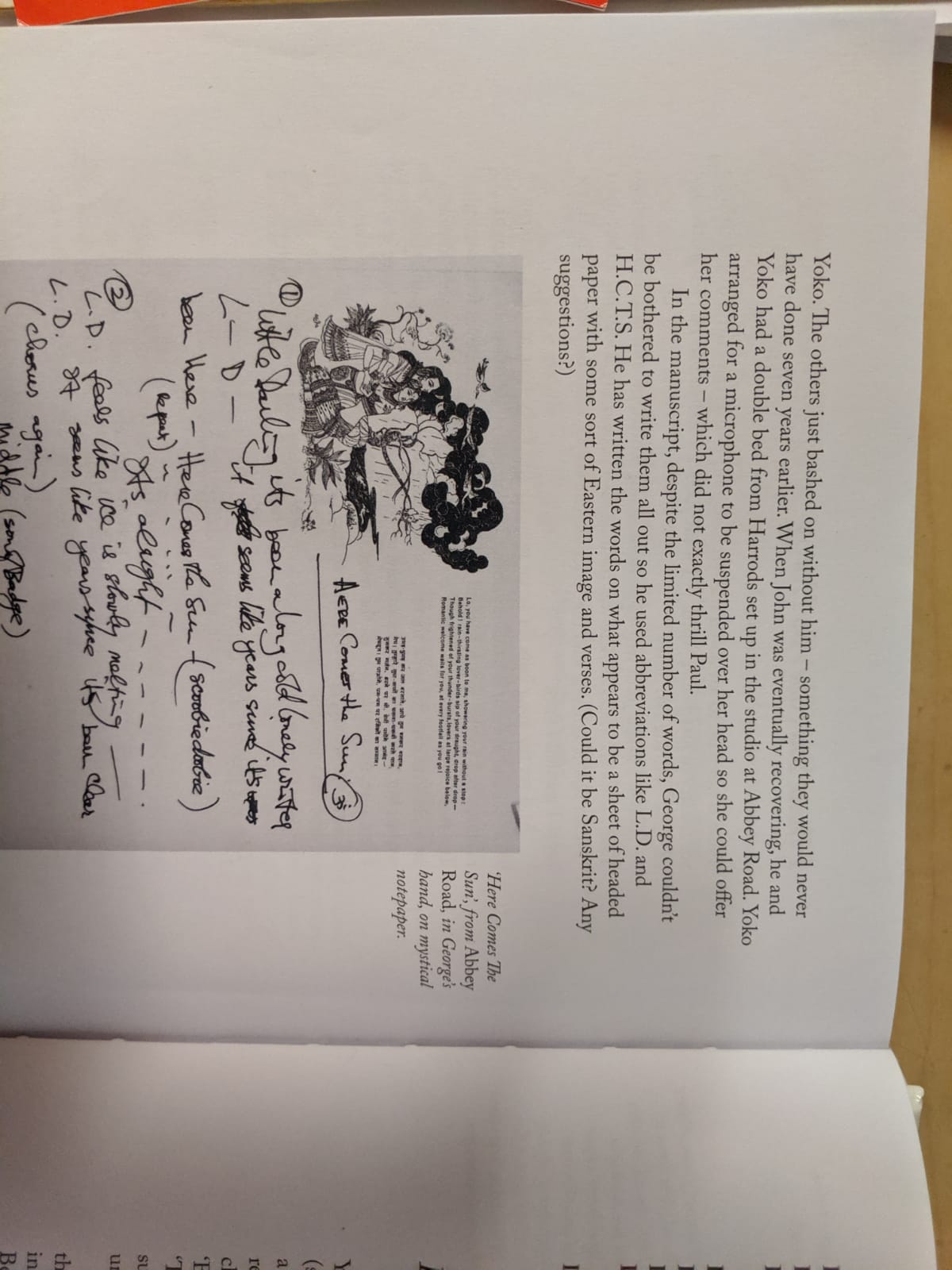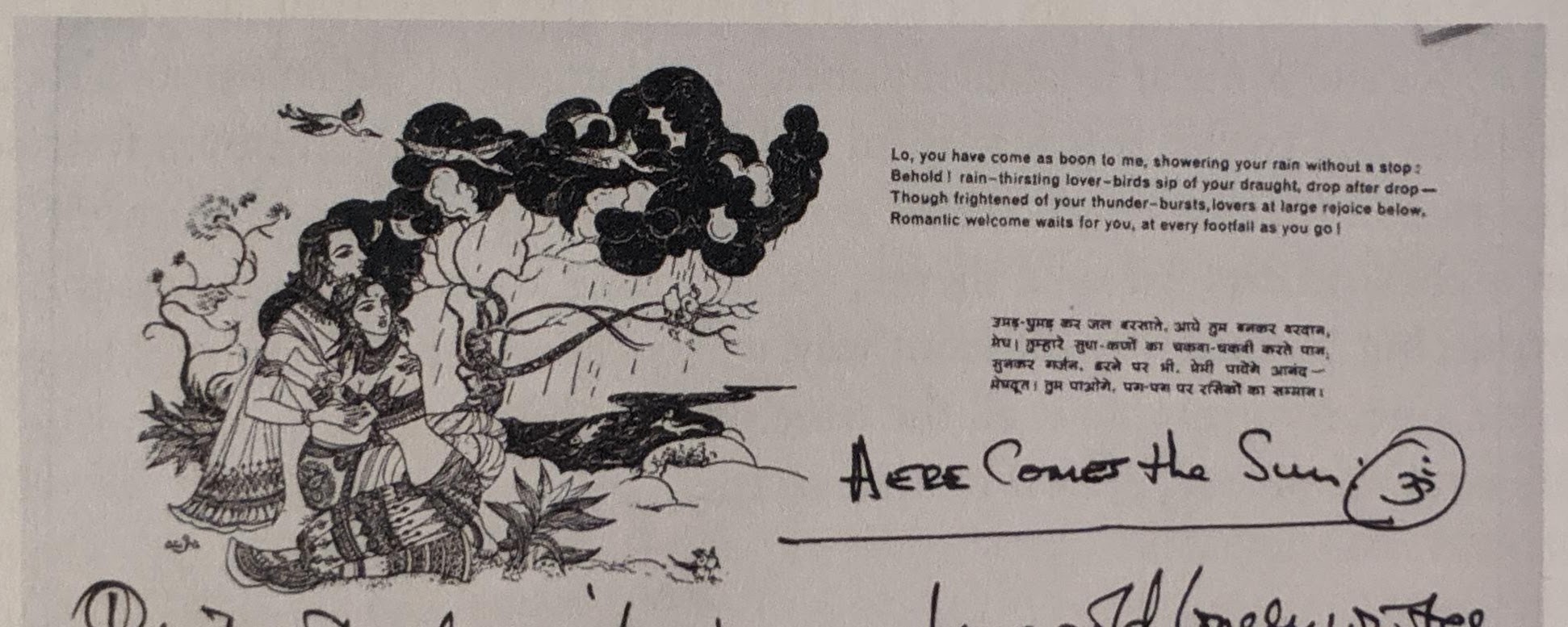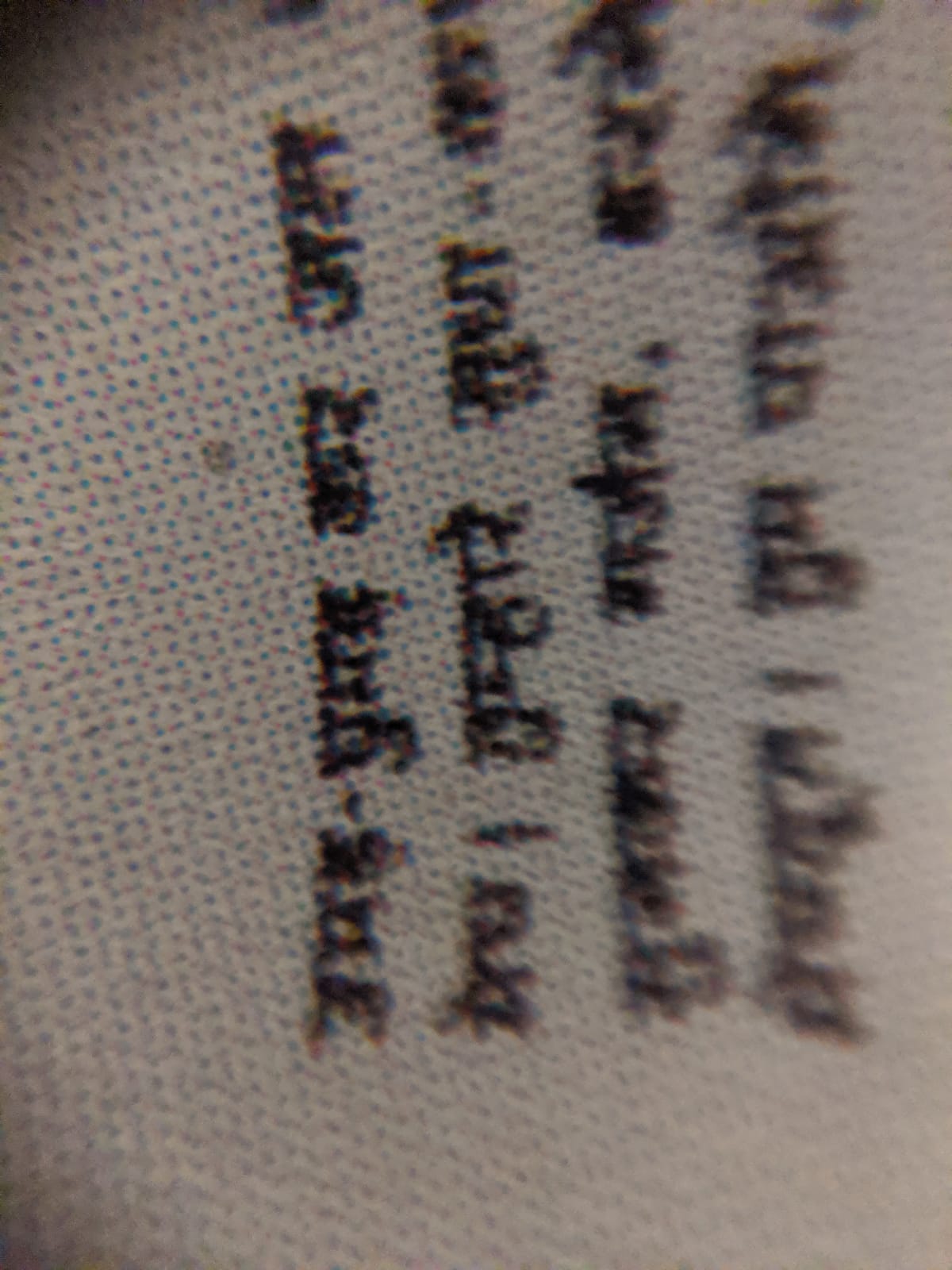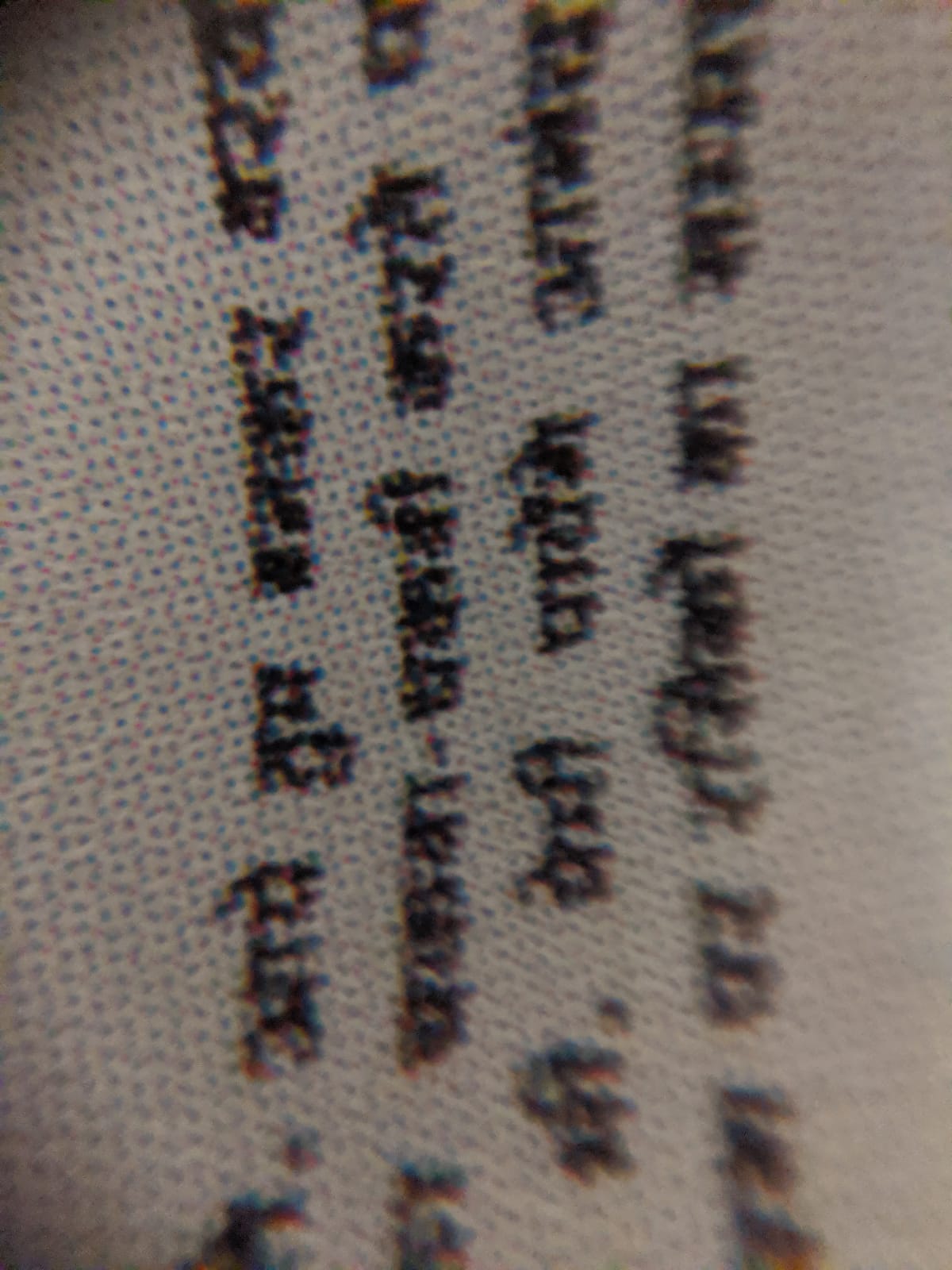The poem in the notepaper used for “Here Comes The Sun”
Background
One day, after a few days of managing to avoid Twitter, I logged in and happened to see these:
👆🏾@suhasm, Are you able to discern which verse it is that's illegibly rendered in the picture?
— Arvind Iyer (@longhandnotes) September 5, 2019
and
Not sure. Don't think its Sanskrit. Prolly Hindi
— Suhas Mahesh (@suhasm) September 5, 2019
(Click here to load the fancier Twitter display for the above tweets—makes a request to Twitter—if you want it for some reason.)
The question was about the second verse printed on the notepaper (the one just above “Hᴇʀᴇ Comes The Sun: ॐ”) in this picture:
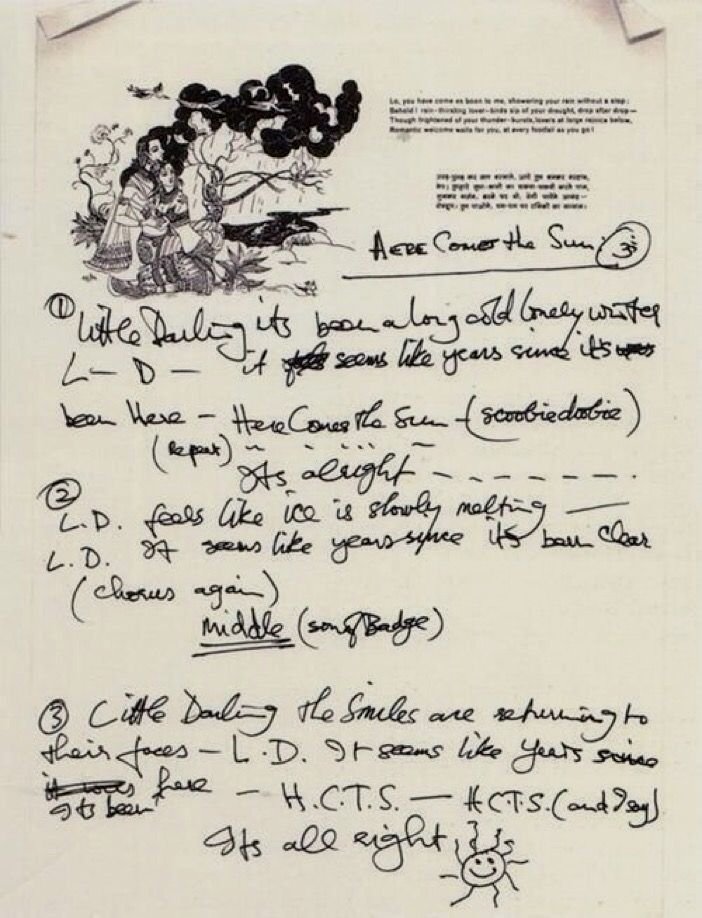
which apparently is the sheet of paper on which George Harrison originally wrote down the lyrics for “Here Comes The Sun”, a song by The Beatles.
With some squinting I was able to make out most of the words in the English verse, but the Devanagari one (which was definitely looking like Hindi by now) was still not very clear (though it seemed to be a translation of the English verse, or more likely the other way around).
With “Search Google for Image” I tried to find higher-resolution images online (enough to read the Hindi), but did not find anything that was really good enough.
But among the results was this slideshow (apparently cbsnews.com is indistinguishable from a clickbait site), which said:
“Here Comes the Sun”
Left: Original lyrics of “Here Comes the Sun” by George Harrison.
According to the Beatles' official biographer, Hunter Davies, the Fab Four never seemed to have any paper in the house. “They never had stationery or notepads,” he told CBS News' Mark Phillips. “The songs suddenly came to them, [and] when it came to the words, they were going ‘round the house going, ‘Gimme some paper. Gimme a scrap.'”
Lyrics that would become timeless classics were often scribbled on hotel stationery, envelopes, even the back of a birthday card.
Davies has now assembled those scraps (which he collected while hanging around the group) and put them into a book, “The Beatles Lyrics” (Little, Brown). Some of these relics are currently on display at the British Library - not far from the Magna Carta.
CREDIT: CBS News
I could not find higher-resolution images on the British Library website but found, to my surprise, that my local library (which, for most of the topics I’m interested in, rarely has the book I’m looking for) had not one but two copies of this book. (Let me not discuss this fact further; cf. the ancient pastime of “Wikigroaning”.)
Anyway, I left office some ten minutes early, reached the library just as it was closing, and managed to check out the book, then take a good look at the verse. Unsurprisingly, quality of print, even(?) for mainstream pop-culture books, is quite a bit higher than that of digital screens, and the verse was easily readable from the book.
The verse
To cut to the answer, this is what the English verse at the top says:
Lo, you have come as boon to me, showering your rain without a stop:
Behold ! rain-thirsting lover-birds sip of your draught, drop after drop —
Though frightened of your thunder-bursts, lovers at large rejoice below,
Romantic welcome waits for you, at every footfall as you go!
And this is clearly someone’s free translation of the Hindi original, which says:
उमड़-घुमड़ कर जल बरसाते, आये तुम बनकर वरदान,
मेघ! तुम्हारे सुधा-कणों का चकवा-चकवी करते पान,
सुनकर गर्जन, डरने पर भी, प्रेमी पायेंगे आनंद −
मेघदूत! तुम पाओगे, पग-पग पर रसिकों का सम्मान ।
Here’s a picture of the whole page, just to show how small it is on the page:
(TODO: take another photo that’s really of the whole page, and with my hand for scale.)
And despite that, the nature of print as a medium, and the minmum expected quality, is such that the poems in the background are readable:
Just to show that there’s not much further useful detail available on the page, here are close-up pictures (taken with a clip-on 25x macro lens attached to a phone) that show the page texture (of course the focus is narrow so the images aren’t very useful in their current state):
Meaning
Let’s take another look at the verse. Here it is, with a somewhat literal and awkward gloss:
So the English verse printed above it is someone’s free translation:
Lo, you have come as boon to me, showering your rain without a stop:
Behold ! rain-thirsting lover-birds sip of your draught, drop after drop —
Though frightened of your thunder-bursts, lovers at large rejoice below,
Romantic welcome waits for you, at every footfall as you go!
- My Hindi isn't good enough so I was actually not sure what the very first words “उमड़-घुमड़ कर” mean. The rhyming pair has an onomatopoeic effect, and the approximate meaning is what I gathered from what dictionaries I could find: 1, 2, 3.
- In English, it seems awkward to specify that a cloud is showering rain (as opposed to what?), or to say that it's showering water — though it's technically correct (I think?), I suspect it's not common to use the word "water" for what comes out of a cloud. English forces an artificial distinction. The trouble with translation is often with what distinctions languages force you to make. (ref)
- I guess "boon" (for वरदान) is one of those words that are very common in English translations of Indian works with a specific well-understood meaning, yet uncommon (see COCA and BNC) in general English. What to do.
- How to translate the vocative into English? Already in 1865 Lewis Carroll parodied saying something like "O Mouse".
- Like वरदान → boon above, सुधा/अमृत → ambrosia/nectar is one of those common translationese problems. You either pick an obscure word that seems out of place, or you pick something that usually has something to do with flowers. To the credit of whoever the translator was, they've avoided both of these; “sip of your draught” is enough.
- The चकवा-चकवी are a pair of birds known in Sanskrit as चक्रवाक (and चक्रवाकी), which are apparently in reality known to form lasting pairs, and about which the common poetic fancy in Sanskrit poetry is that they are separated at night and mourn each other till reunion in the morning. I'm not aware of any convention about them drinking rain water (unlike the चातक bird). Maybe the author mixed up the two. Or, there's no reason any bird couldn't drink rainwater I guess.
- No doubt the sight (or "sound") of a cloud can bring joy to those who need the water, but it's not clear why lovers specifically would rejoice: the trope in Sanskrit literature used to be that the rains are actually a time of misery for separated lovers, because the roads become impassable so they can't be reunited until the end of the rainy season. But I guess the arrival of rain is joyous in general, and lovers are included :)
- The cloud, earlier addressed simply as मेघ, is now addressed again, as मेघदूत this time. There is nothing in this verse specifically about the cloud being a messenger in any way, but such is the popularity of Kalidasa's classic work that a cloud can simply be called "मेघदूत" and nothing seems out of place.
- What's a good translation for रसिकों? The "romantic welcome" for "रसिकों का सम्मान" seems a good choice.
Metre
I find the comma on the last line after पाओगे interesting. As I understand it, there is nothing in the meaning or grammar that strictly requires it; this is probably here because of the “add a comma whenever you want” rule.
The other interesting possibility is that the comma is there to indicate an actual pause in recitation. If one ignores the comma, the poem can be read in a natural metre, by groups of 4 mātrās (with an ūna-gaṇa / catalexis on each line):
| 8 | 8 | 8 | 8 | ||||
| 4 | 4 | 4 | 4 | 4 | 4 | 4 | (4) |
| उमड़-घुमड़ कर | जल बर | साते, | आये | तुम बन | कर वर | दान, — | |
| 8 | 8 | 8 | 8 | ||||
| 4 | 4 | 4 | 4 | 4 | 4 | 4 | (4) |
| मेघ! तुम्हारे | सुधा-क | णों का | चकवा | -चकवी | करते | पान, — | |
| 8 | 8 | 8 | 8 | ||||
| 4 | 4 | 4 | 4 | 4 | 4 | 4 | (4) |
| सुनकर | गर्जन, | डरने | पर भी, | प्रेमी | पायें | गे आ | नंद − |
| 8 | 8 | 8 | 8 | ||||
| 4 | 4 | 4 | 4 | 4 | 4 | 4 | (4) |
| मेघदूत! तुम | पाओ | गे, पग- | पग पर | रसिकों | का सम्मान । | ||
With the comma too (indicating a pause), it is possible to read it naturally, if one drops two mātrās that come later (say the पर):
| 8 | 8 | 8 | 8 | ||||
| 4 | 4 | 4 | (4) | 4 | 4 | 4 | 4 |
| मेघदूत! तुम | पाओ | गे, — | पग-पग | रसिकों | का सम्मान । | ||
In principle one can keep the comma and the line unaltered:
| 8 | 8 | 8 | 8 | ||||
| 4 | 4 | 4 | (4) | 4 | 4 | 4 | 4 |
| मेघदूत! तुम | पाओ | गे, — | पग-पग | पर रसि | कों का सम्मान । | ||
but that sounds odd for some reason.
My guess is that both versions were in use / being considered, and somehow someone added a comma to the version that does not need it.
Questions
Even with the mystery of what the verse says being solved, there are only further questions: Who wrote the Hindi verse, and who translated it? Where did this piece of paper come from? Are there others like it? (It looks really cool!) There is some stuff in Davies’s book (and, I imagine, other books of his) about the timeline of when the Beatles visited India etc.; maybe one can narrow things down.
And who are the characters depicted on it? Some people on the Twitter thread imagine them to be specific characters from the literature, possibly based on their non-modern attire, but my guess is that they simply stand for generic lovers—the प्रेमी of the poem—like Kalidasa’s unnamed कश्चित् यक्षः and his कान्ता.
Postscript
This is why I should avoid Twitter (and everything else). :-)
